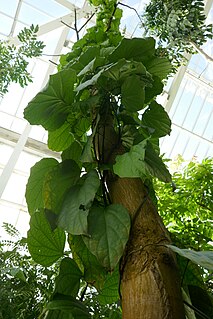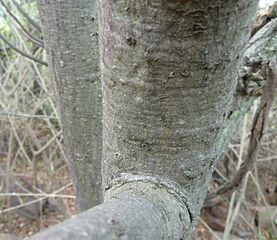
Canna or canna lily is the only genus of flowering plants in the family Cannaceae, consisting of 10 species. Cannas are not true lilies, but have been assigned by the APG II system of 2003 to the order Zingiberales in the monocot clade Commelinids, together with their closest relatives, the gingers, spiral gingers, bananas, arrowroots, heliconias, and birds of paradise.

Colophospermum mopane, commonly called mopane, mopani, balsam tree, butterfly tree, or turpentine tree, is a tree in the legume family (Fabaceae), that grows in hot, dry, low-lying areas, 200 to 1,150 metres in elevation, in the far northern parts of southern Africa. The tree only occurs in Africa and is the only species in genus Colophospermum. Its distinctive butterfly-shaped (bifoliate) leaf and thin seed pod make it easy to identify. In terms of human use it is, together with camel thorn and leadwood, one of the three regionally important firewood trees.

Datura discolor, also called the desert thorn-apple, is an herbaceous annual plant native to the Sonoran Desert of western North America, where it grows in sandy soils and washes. All parts of the plant contain a mix of alkaloids that are potentially lethal when enough is ingested. Deaths from careless recreational use of Datura and related plants are frequently reported.

The grey go-away-bird, also known as grey lourie, grey loerie, or kwêvoël, is a bold and common bird of the southern Afrotropics. They are present in arid to moist, open woodlands and thorn savanna, especially near surface water. They regularly form groups and parties that forage in tree tops, or dust bathe on the ground. Especially when disturbed, they make their presence known by their characteristically loud and nasal "kweh" or "go-way" calls, with the last syllable typically a descending drawl. Within range, their unique combination of appearance and habits precludes confusion with other bird species.

Lannea is a genus of plants in the family Anacardiaceae.

Leucadendron discolor is a species of plant in the family Proteaceae. It is endemic to South Africa. It is threatened by habitat loss. In English the plant is known as the Piketberg Conebush and in Afrikaans as the Rooitolbos. L. discolor is a slow growing perennial. Growth of the root system and propagation, from a seed to the plant's first flower, can take up to two years. The male L. discolor 'Sunset' flowers exuberantly during early spring exposing a colorful flowerhead during this time.The flower head is composed of a dome-like receptacle, and is densely covered with small male flowers. These plants are only able to reproduce after their third year of life.

Burkea africana, the wild syringa, is a deciduous, medium-sized, spreading, flat-topped tree belonging to the subfamily Caesalpinioideae of the family Fabaceae. The genus was named in honour of Joseph Burke, the botanist and collector.
Dikbas is a common name for several plants and may refer to:

Dendroconche scandens, synonym Microsorum scandens, commonly called fragrant fern, is a species of fern within the family Polypodiaceae. This species is native to parts of New Zealand and Australia, as well as some offshore islands. It has been introduced to South Africa and Zimbabwe. An example occurrence in New Zealand's North Island is in the Hamilton Ecological District where it is associated with a number of other ferns including Icarus filiforme and Lomaria discolor.

Ludisia (Lus.) is a genus of orchids that was thought to contain just one species, Ludisia discolor, commonly referred to as jewel orchid. A second species, Ludisia ravanii, from the Philippines, was described in 2013. Ludisia discolor is native to Southern China, Northeast India, Thailand, Vietnam, the Philippines, Malaysia, Indonesia and Myanmar, and often cultivated.

Brachylaena discolor is a species of flowering plant in the aster family, Asteraceae. It is native to Africa, where it occurs in Mozambique, South Africa, and Eswatini. Its common names include coast silver oak and coastal silver oak.

Pseudacraea boisduvali, or Boisduval's false acraea, is a butterfly of the family Nymphalidae. It has an extensive range which includes much of the tropics and subtropics of sub-Saharan Africa.

Combretum apiculatum is a species of tree in the family Combretaceae known by the common name red bushwillow. It is native to the mesic to semi-arid savanna regions of Africa, southwards of the equator.

Englerophytum natalense, the silver-leaf milkplum, is a medium-sized, evergreen tree that occurs along forested escarpments from East Africa to South Africa. The leaves are alternately arranged or spiralled, and to some extent crowded near the ends of branches. They are glossy green to greyish green above and covered in silvery hairs below. The stem is straight and the bark smooth. Young branches are covered with dense brownish hairs. The plant contains a milky latex.

Tetradenia is a genus of plants in the family Lamiaceae, first described in 1830. It is native to Africa, including Madagascar.
- Tetradenia bainesii(N.E.Br.) Phillipson & C.F.Steyn - Zimbabwe, Mozambique, Swaziland, KwaZulu-Natal
- Tetradenia barberae(N.E.Br.) Codd - Cape Province
- Tetradenia brevispicata(N.E.Br.) Codd - Zimbabwe, Namibia, Botswana, Transvaal
- Tetradenia clementianaPhillipson - Madagascar
- Tetradenia cordataPhillipson - Madagascar
- Tetradenia discolorPhillipson - Zambia, Zaire, Zimbabwe, Malawi, Tanzania
- Tetradenia falafaPhillipson - Madagascar
- Tetradenia fruticosaBenth. - Madagascar
- Tetradenia galpinii(N.E.Br.) Phillipson & C.F.Steyn - southeast Africa from Tanzania to Swaziland
- Tetradenia goudotiiBriq. - Madagascar
- Tetradenia herbacea Phillipson - Madagascar
- Tetradenia hildeanaPhillipson - Madagascar
- Tetradenia isaloensisPhillipson - Madagascar
- Tetradenia kaokoensisvan Jaarsv. & A.E.van Wyk - Namibia
- Tetradenia multiflora(Benth.) Phillipson - Ethiopia
- Tetradenia nervosaCodd - Madagascar
- Tetradenia riparia(Hochst.) Codd - southern Africa from Angola + Malawi to Swaziland
- Tetradenia tanganyikaePhillipson - Malawi, Tanzania, Zambia
- Tetradenia tuberosaT.J.Edwards - KwaZulu-Natal
- Tetradenia urticifolia(Baker) Phillipson - eastern + central Africa from Sudan + Eritrea south to Zaire and Tanzania

Brachylaena rotundata S. Moore is an occasionally deciduous Southern African shrub or small tree growing to some 8m in height and of the family Asteraceae. It occurs in eastern Botswana, Transvaal, Mozambique, Zambia and Zimbabwe, growing in open woodland, on rocky koppies and slopes, and on stream banks. Kew accepts Brachylaena rotundata S. Moore as a species while 'Flora of Mozambique' treats it as a variety of Brachylaena discolor DC. It bears attractive foliage, green on the upper surface and silver-grey on the lower, leaves turning slightly reddish in autumn.
Leaves with petioles from 2 mm to 7 mm. long, lamina 4–15 x 2.5–6 cm., larger on coppice shoots, broadly oblanceolate or elliptic, obtuse to rounded at the apex, cuneate or rounded base, entire, occasionally coarsely dentate near the apex; upper surface araneous when young, or glabrescent; lower surface greyish tomentellous with prominent veins. Capitula sometimes preceding the leaves, young synflorescences with buds in axillary and terminal spikes, mature synflorescences with numerous capitula in dense terminal panicles 4–40 cm. long, or in short raceme-like panicles in axils of old leaves. Involucres cyathiform to obconic. Phyllaries minutely glandular outside, subobtuse, margins ciliolate, the outer phyllaries from c. 1 mm. long and ovate, the inner to c. 5 mm. long becoming lorate-lanceolate, narrowly obtuse or blunt at the apex; the outermost 5–8 series decreasing in size and extending down to the base of the capitulum stalk. Male flowers: corollas dull-yellow, 3–5 mm. long, lobes c. 1.5 mm. long and ± recurved; pappus uniseriate, setae 3–4 mm. long, subplumose, the seta barbs exceeding the seta axis in width. Female flowers: corollas dull-yellow, 3–5 mm. long, filiform, lobes erect up to c. 0.5 mm. long; achenes c. 4 mm. long, subcylindric-fusiform, narrowly c. 8-ribbed, pubescent; pappus 2-several-seriate, setae 4–5 mm. long, ± terete or flattened, seta barbs ± equalling the seta axis in width.""

Lannea welwitschii is a species of tree in the family Anacardiaceae. It is native to the tropical rainforests of West and Central Africa. The timber is used to make furniture and utensils and for many other purposes, the fruits can be eaten, and the bark is used to produce a dye, for making rope and in traditional medicine.
Lannea schweinfurthii is a small to medium sized deciduous tree within the Anacardiaceae family. The tree is sometimes called 'bastard marula' or 'false marula' because when it is without flowers or fruits, it become quite similar to the marula tree and sometimes confused for the marula tree. Extracts of the species is used in traditional human and veterinary medical practices.
Lannea edulis is a small deciduous shrub that commonly occurs in East and Southern Africa, it belongs to the Anacardiaceae family.



















